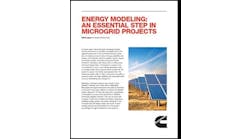Connecticut, one of the earliest states to advocate for microgrids, is now getting ready to release its fourth round of microgrid incentives, this time $26.5 million in grants.
The new round begins September 1, with the Department of Energy and Environmental Protection (DEEP) accepting applications through January 1 for community microgrid projects.
The latest round of microgrid incentives comes as the state winds down its third offering that ends August 31. From that pot of money — $30 million — the state has awarded $424,000 and has preliminarily set aside $3 million for a project that is currently under review, leaving the $26.5 million for the fourth round. (If the $3 million is not awarded to the Round 3 applicant, that money will be available in Round 4, as well.)
Under the fourth round, the state will offer grants of up to $4 million per project. An additional $2 million is available for microgrids in towns that received certain assistance from the US Department of Agriculture’s Rural Community Energy Assistance Program.
The fourth round of grant money may be be used to cover costs for design, engineering, electrical and interconnection infrastructure.
Applicants also can use the funds for capital costs associated with energy storage or Class I and Class III clean energy resources, with matching funds provided by the project developer. (Class I and III resources are defined under the state’s renewable portfolio standard. They include a broad range of technologies, including solar, wind, combined heat and power, and conservation and load management. Trash-to-energy facilities are excluded.)
In addition to the grant money, projects may apply for loans of up to $2 million from the Connecticut Green Bank.
Born out of power outages caused by severe ice and snow storms, the fourth round of funding — like the first three — focuses on microgrids that can keep the power flowing to facilities that are critical to society, such as police departments, wastewater treatment facilities, hospitals grocery stores, hospitals, cell phone towers and shelters.
“Through this program we have provided financial support to important projects around the state – and with our new round of funding we are looking to encourage additional projects that will provide a real backstop to the inconveniences and public health and safety risks created when the light go out,” said Robert Klee, DEEP commissioner.
After fourth round grant winners execute a contract with DEEP they must meet certain milestones on schedule. For example, projects must go into construction within 15 months and begin commercial operation within 36 months.
Municipalities and others that are interested in receiving a round four grant or loan can find the application instructions and other relevant information at the DEEP Energy Filings Webpage.
Connecticut was the first state to kick off a comprehensive microgrid grant and loan program. The program emerged out of a legislative package offered by Gov. Malloy in 2012 after several major storms caused widespread power outages.
DEEP conducted its first two rounds of microgrid incentives in 2013 and 2014 and received applications on a rolling basis from 2015 to 2017. The state began accepting applications for the third round in 2015, and will continue to do so until the end of August.
So far, the state has granted $20.5 million for ten projects. Six microgrids are operating; four more are under construction. The winners include the City of Milford, University of Bridgeport, University of Connecticut, Wesleyan, University of Hartford, U.S. Navy submarine base in Groton, Town of Windham, Town of Woodbridge, City of Hartford and Town of Fairfield.
More details about the program are available on DEEP’s Microgrid Program page.
Track news about microgrid subsidies. Subscribe to the free Microgrid Knowledge newsletter.






